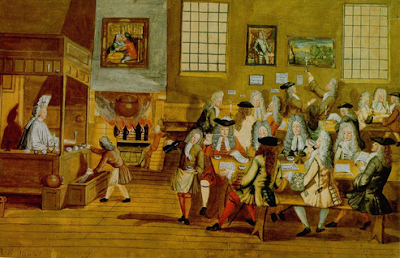 |
| John Banister, court Violinist to King Charles II of England |
Although the name and person of this 17th century Composer and master of the violin, astonishingly, would fade into relative obscurity (and continues to be anything but a household name), Banister would put a little district in London, England called Whitefriars on the world’s cultural map when he orchestrated the first ever regular series of public concerts for profit in his home[1] situated in the area in late December of 1672.
Although much of Banister’s initial audiences were aristocrats of the period (many of which the violinist may have first made acquaintance during his seven year tenure as a member (and later leader of) the ‘king’s band’ of 24 violinists under King Charles II of England), this new foray into the arena of music for profit would help usher into Europe a new age of musical enlightenment. For so long, music had been cloistered under the asphyxiating restrictions of royal, sacred and secular aristocratic patronage – presenting an uphill battle for a decent, or at least livable – wage for it’s creators and innovators, who often had to resort to a battle of wits and form underhanded connections just to move up in rank or to obtain a steady post and pay – and which also remarkably denied the middle and lower classes from being able to hear and enjoy music at their leisure.
This would change dramatically following Banister’s inaugural concert, where audiences would find themselves at last not only enjoying music for pleasure, but also finding themselves in the power seat holding the reins: for a payment of 1 shilling, concert-goers – customers – would find themselves able to request compositional works to be played on demand. It was exhilarating – moreover – it was empowering for the middle classes, who would soon find themselves emerging from the blighted plains of the performing arts held hostage by the Monarchy and the Church, and spilling into the taverns and coffee-houses whose proprietors would quickly follow Banister’s suit by holding commercial concerts of their own, finding they too could reap the benefits of this successful venture by showcasing musical themed floors (by instrument or voice, by language sung, by notoriety of the musician(s) performing) and charging fees on an escalating scale according to audience preference, which they would split with the performer(s).
 |
| A contemporary depiction of the interior of a London Coffeehouse, 17th Century |
It is exceedingly curious that John Banister’s contribution to classical music – nay, to music itself – continues to go unnoticed. In an age where concert-going is as much a privilege (in the modern sense of the word) as it is a much beloved pastime, common knowledge of its origins ought to be treated as sacrosanct - and we all should pay homage to it's creator.
Footnotes:
[1] There is some confusion regarding the location of Banister’s inaugural concert at Whitefriars. Some sources of note, including the Encyclopædia Britannica, list the venue as the musicians ‘private home’, while other, more dated (contemporaneous) accounts suggest a series of performances having originated in a “publik house in white fryars; filled...with tables and seats…” [R. North, Musical Grammarian, The; p.30]
-Rose.

No comments:
Post a Comment